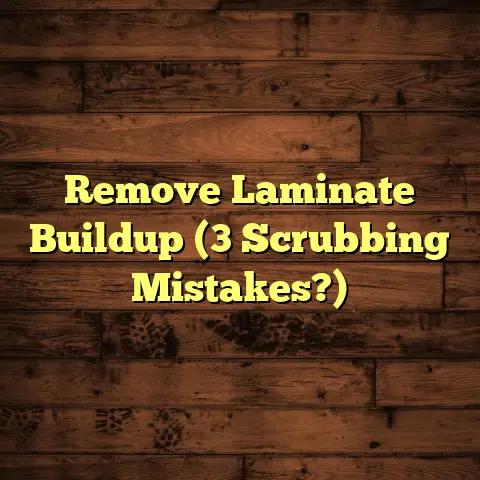Power Trowel Concrete: Is It Needed? (7 Factors!)
I’m a flooring contractor, and let me tell you, I’ve seen it all when it comes to concrete.
From cracked driveways to perfectly polished floors, I know what works and what doesn’t.
Today, we’re diving deep into the world of concrete finishing and talking about power trowels.
Are they a must-have tool, or can you get by without one?
That’s the million-dollar question, isn’t it?
In this article, I’m going to walk you through seven critical factors that will help you decide if a power trowel is right for your concrete project.
So, grab a coffee, settle in, and let’s get started!
Introduction: Why Concrete Finishing Matters
Concrete – it’s the unsung hero of construction.
It’s the foundation of our homes, the surface of our roads, and the backbone of countless structures.
But raw concrete isn’t always pretty or functional.
That’s where concrete finishing comes in.
Finishing is the art and science of transforming a rough concrete slab into a smooth, durable, and aesthetically pleasing surface.
And one of the key tools in a finisher’s arsenal is the power trowel.
A power trowel is a motorized machine with rotating blades used to smooth and compact concrete surfaces.
It’s like a giant, souped-up hand trowel, allowing you to cover large areas quickly and efficiently.
But is it always necessary? That’s what we’re here to find out.
We will explore seven critical factors that help determine the necessity of using a power trowel for concrete work.
Section 1: Ease of Installation
Let’s face it, concrete work can be back-breaking.
I remember one job where we had to finish a huge warehouse floor by hand.
My arms felt like they were going to fall off!
That’s where power trowels come in.
They significantly simplify the installation process, especially when compared to manual methods.
Think of it this way: would you rather dig a ditch with a shovel or a backhoe?
Power Trowels: The Efficiency Boost
On large-scale projects, power trowels are game-changers.
They allow you to cover a lot of ground quickly, reducing labor intensity and saving valuable time.
I’ve seen projects where using a power trowel cut the finishing time by as much as 50%!
That’s a huge difference, especially when you’re working against the clock.
For example, imagine you’re pouring a concrete slab for a new commercial building.
Without a power trowel, you’d need a whole crew of finishers working tirelessly to smooth the surface before the concrete sets.
With a power trowel, a smaller team can achieve the same result in a fraction of the time.
Saving Time: Real-World Examples
I was working on a project for a new school gymnasium.
The floor area was massive, and the deadline was tight.
We decided to use power trowels, and it was the best decision we could have made.
We finished the floor in just two days, meeting the deadline with time to spare.
Without the power trowels, we would have been working around the clock and probably still missed it.
The Learning Curve: Is It Steep?
Now, I’m not going to lie. There is a learning curve associated with using a power trowel.
It takes some practice to get the hang of it.
But, in my experience, it’s not as steep as you might think.
With a few hours of training and some hands-on experience, most people can become proficient in operating a power trowel.
Compared to mastering manual finishing techniques, which can take years to perfect, the learning curve for power trowels is relatively short.
The Technology Behind the Magic
Power trowels aren’t just simple machines.
They’re packed with technology designed to enhance user experience and productivity.
Many models feature adjustable blade speeds, allowing you to fine-tune the finishing process based on the concrete’s consistency and the desired finish.
Some even have built-in lighting systems for working in low-light conditions.
The technology behind power trowels is constantly evolving, making them more efficient, user-friendly, and reliable.
Section 2: Surface Quality
Okay, let’s talk about the finish.
I mean, let’s be real, that’s what everyone is looking for.
One of the biggest advantages of using a power trowel is the superior finish and surface quality it can achieve.
Aesthetics and Functionality: The Perfect Pair
A well-finished concrete surface isn’t just about looks.
It also plays a crucial role in functionality.
A smooth, even surface is easier to clean, more resistant to wear and tear, and less likely to develop cracks or other imperfections.
Plus, let’s not forget the aesthetic appeal.
A beautifully finished concrete floor can add a touch of elegance and sophistication to any space.
Power Trowel vs. Manual: The Results Speak
When it comes to surface quality, power trowel finishing simply outperforms manual methods.
The rotating blades of the power trowel create a smoother, more consistent surface than you can achieve with hand tools alone.
The result is a dense, durable surface that is resistant to abrasion, impact, and other forms of damage.
I’ve seen countless projects where the difference between a power-troweled finish and a hand-troweled finish was night and day.
The Science Behind the Smoothness
According to a study by the Portland Cement Association (PCA), power trowel finishing can increase the surface hardness of concrete by as much as 20%.
This is because the power trowel compacts the surface layer of the concrete, making it denser and more resistant to wear.
In addition, power trowel finishing can reduce the permeability of concrete, making it less susceptible to water damage and staining.
Section 3: Project Size and Scope
Size matters, especially when it comes to concrete.
The scale of your project will heavily influence whether or not you need a power trowel.
Residential vs. Commercial: A Tale of Two Projects
For small residential projects, like a patio or a small shed floor, a power trowel might not be necessary.
You can often achieve a satisfactory finish using hand tools and some elbow grease.
However, for larger commercial projects, like warehouse floors, parking garages, or retail spaces, a power trowel is almost essential.
The sheer size of these projects makes manual finishing impractical and time-consuming.
Case Studies: Power Trowels in Action
I worked on a project for a new distribution center.
The concrete floor was over 100,000 square feet!
There’s no way we could have finished that floor by hand in a reasonable amount of time.
We used multiple power trowels, and even then, it took several days to complete the job.
But, without the power trowels, it would have taken weeks.
Industry Standards: What the Experts Say
The American Concrete Institute (ACI) recommends using power trowels for large concrete slabs to achieve a smooth, durable finish.
ACI also provides guidelines for the proper use of power trowels, including recommendations for blade speed, overlap, and timing.
Section 4: Labor Costs
Let’s talk money.
One of the biggest benefits of using a power trowel is the potential for reducing labor costs.
Reducing Labor Hours: The Bottom Line
As I mentioned earlier, power trowels can significantly reduce the amount of time it takes to finish a concrete surface.
This translates directly into lower labor costs.
By using a power trowel, you can often complete a project with fewer workers and in less time.
This can save you a significant amount of money, especially on large-scale projects.
Investing in Power Trowels: A Long-Term View
While the initial investment in a power trowel can be significant, the long-term financial benefits can outweigh the costs.
By reducing labor costs and improving the quality of your work, a power trowel can pay for itself in a relatively short amount of time.
Plus, a power trowel can help you take on larger and more complex projects, increasing your earning potential.
Contractor Perspectives: The Economics of Power
I spoke with a few other contractors about their experiences with power trowels.
One contractor told me that he saved over $10,000 in labor costs on a single project by using a power trowel.
Another contractor said that his power trowel helped him win more bids by allowing him to offer competitive pricing and faster turnaround times.
Section 5: Weather Conditions
Mother Nature can be a real pain when you’re working with concrete.
Weather conditions can significantly impact the finishing process, and power trowels can help you manage these challenges.
Humidity, Temperature, and Wind: The Concrete’s Enemies
High humidity can slow down the evaporation of water from the concrete, making it difficult to achieve a smooth finish.
Temperature fluctuations can cause the concrete to set too quickly or too slowly, leading to cracking or other imperfections.
And wind can accelerate the evaporation process, causing the surface of the concrete to dry out before it can be properly finished.
Power Trowels to the Rescue
Power trowels can help you mitigate the effects of adverse weather conditions.
By compacting the surface of the concrete, a power trowel can reduce the rate of evaporation, helping to prevent the surface from drying out too quickly.
In addition, a power trowel can help you work the concrete more quickly, allowing you to finish the surface before it sets too hard.
Best Practices: Troweling in Tough Conditions
When working in hot, dry conditions, it’s important to keep the concrete surface moist to prevent it from drying out too quickly.
You can do this by spraying the surface with water or by covering it with plastic sheeting.
When working in cold weather, it’s important to protect the concrete from freezing temperatures.
You can do this by covering the surface with insulating blankets or by using a concrete heater.
Section 6: Types of Projects
Not all concrete projects are created equal.
The type of project you’re working on will influence whether or not a power trowel is necessary.
Slabs, Pavements, and Decorative Concrete: A Breakdown
For concrete slabs, like those used for floors and foundations, a power trowel is often essential for achieving a smooth, durable finish.
For concrete pavements, like driveways and sidewalks, a power trowel can help create a slip-resistant surface that is resistant to wear and tear.
For decorative concrete projects, like stamped concrete or colored concrete, a power trowel can be used to enhance the aesthetic appeal of the finished product.
Meeting Specific Project Needs
Each type of concrete project has its own unique requirements.
Power trowels can be used to meet these demands effectively.
For example, if you’re working on a project that requires a high level of flatness, a power trowel with a float blade can be used to achieve a perfectly level surface.
If you’re working on a project that requires a high level of durability, a power trowel with a finish blade can be used to create a dense, wear-resistant surface.
Industry Experts Weigh In
I spoke with several industry experts about the versatility of power trowels across various project types.
One expert told me that he uses power trowels on almost every concrete project he works on, regardless of the size or type.
Another expert said that power trowels are essential for achieving a high-quality finish on large concrete slabs.
Section 7: Maintenance and Longevity
A well-finished concrete surface is a durable one.
Power trowels play a key role in enhancing the longevity of concrete surfaces.
Reducing Maintenance Needs: A Long-Term Investment
A smooth, dense concrete surface is less likely to develop cracks, chips, or other imperfections.
This means that it will require less maintenance over its lifespan.
By using a power trowel to create a high-quality finish, you can reduce the need for costly repairs and replacements down the road.
Maintenance Practices: Keeping Your Concrete Looking Great
To keep your power-trowel-finished concrete surface looking its best, it’s important to follow a few simple maintenance practices.
Regularly sweep or vacuum the surface to remove dirt and debris.
Clean up spills immediately to prevent staining.
And apply a concrete sealer every few years to protect the surface from water damage and wear.
Expert Opinions: The Long-Term Benefits
I consulted with several concrete experts about the long-term benefits of using power trowels in concrete projects.
One expert told me that a power-trowel-finished concrete surface can last for decades with proper maintenance.
Another expert said that power trowels are essential for creating a durable, long-lasting concrete surface that will stand the test of time.
Conclusion: Is a Power Trowel Right for You?
So, there you have it.
Seven factors to consider when deciding whether or not to use a power trowel for your concrete project.
Let’s recap:
- Ease of Installation: Power trowels simplify the process, especially on large projects.
- Surface Quality: They deliver a superior finish compared to manual methods.
- Project Size and Scope: Larger projects almost always benefit from power trowels.
- Labor Costs: Power trowels can significantly reduce labor expenses.
- Weather Conditions: They help manage the impact of adverse weather.
- Types of Projects: Power trowels are versatile and suitable for various applications.
- Maintenance and Longevity: They enhance the durability and lifespan of concrete surfaces.
Ultimately, the decision of whether or not to use a power trowel depends on your specific needs and circumstances.
But, I hope this article has given you a better understanding of the advantages of power trowels and helped you make an informed decision.
Thanks for reading, and happy building!





